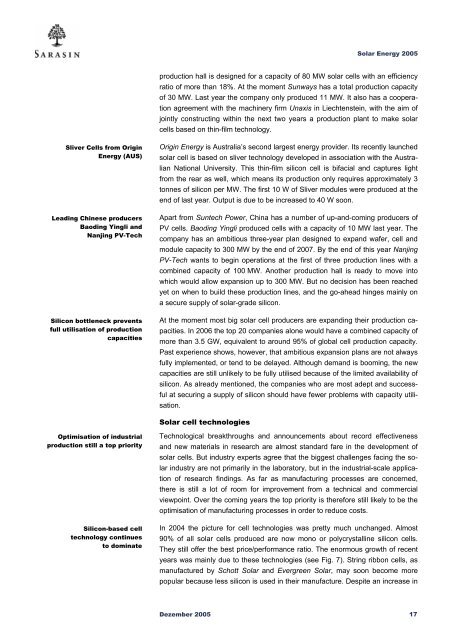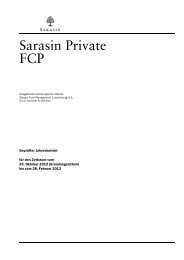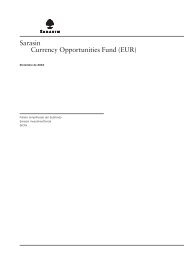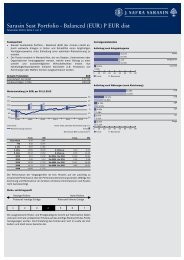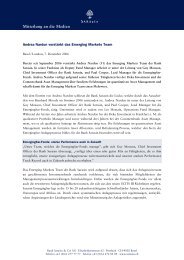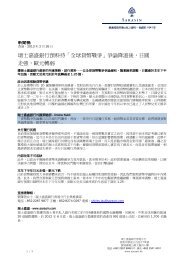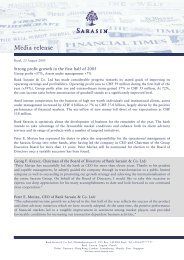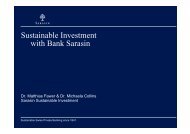Sustainability Report - Bank Sarasin-Alpen
Sustainability Report - Bank Sarasin-Alpen
Sustainability Report - Bank Sarasin-Alpen
You also want an ePaper? Increase the reach of your titles
YUMPU automatically turns print PDFs into web optimized ePapers that Google loves.
Solar Energy 2005<br />
production hall is designed for a capacity of 80 MW solar cells with an efficiency<br />
ratio of more than 18%. At the moment Sunways has a total production capacity<br />
of 30 MW. Last year the company only produced 11 MW. It also has a cooperation<br />
agreement with the machinery firm Unaxis in Liechtenstein, with the aim of<br />
jointly constructing within the next two years a production plant to make solar<br />
cells based on thin-film technology.<br />
Sliver Cells from Origin<br />
Energy (AUS)<br />
Leading Chinese producers<br />
Baoding Yingli and<br />
Nanjing PV-Tech<br />
Silicon bottleneck prevents<br />
full utilisation of production<br />
capacities<br />
Origin Energy is Australia’s second largest energy provider. Its recently launched<br />
solar cell is based on sliver technology developed in association with the Australian<br />
National University. This thin-film silicon cell is bifacial and captures light<br />
from the rear as well, which means its production only requires approximately 3<br />
tonnes of silicon per MW. The first 10 W of Sliver modules were produced at the<br />
end of last year. Output is due to be increased to 40 W soon.<br />
Apart from Suntech Power, China has a number of up-and-coming producers of<br />
PV cells. Baoding Yingli produced cells with a capacity of 10 MW last year. The<br />
company has an ambitious three-year plan designed to expand wafer, cell and<br />
module capacity to 300 MW by the end of 2007. By the end of this year Nanjing<br />
PV-Tech wants to begin operations at the first of three production lines with a<br />
combined capacity of 100 MW. Another production hall is ready to move into<br />
which would allow expansion up to 300 MW. But no decision has been reached<br />
yet on when to build these production lines, and the go-ahead hinges mainly on<br />
a secure supply of solar-grade silicon.<br />
At the moment most big solar cell producers are expanding their production capacities.<br />
In 2006 the top 20 companies alone would have a combined capacity of<br />
more than 3.5 GW, equivalent to around 95% of global cell production capacity.<br />
Past experience shows, however, that ambitious expansion plans are not always<br />
fully implemented, or tend to be delayed. Although demand is booming, the new<br />
capacities are still unlikely to be fully utilised because of the limited availability of<br />
silicon. As already mentioned, the companies who are most adept and successful<br />
at securing a supply of silicon should have fewer problems with capacity utilisation.<br />
Solar cell technologies<br />
Optimisation of industrial<br />
production still a top priority<br />
Silicon-based cell<br />
technology continues<br />
to dominate<br />
Technological breakthroughs and announcements about record effectiveness<br />
and new materials in research are almost standard fare in the development of<br />
solar cells. But industry experts agree that the biggest challenges facing the solar<br />
industry are not primarily in the laboratory, but in the industrial-scale application<br />
of research findings. As far as manufacturing processes are concerned,<br />
there is still a lot of room for improvement from a technical and commercial<br />
viewpoint. Over the coming years the top priority is therefore still likely to be the<br />
optimisation of manufacturing processes in order to reduce costs.<br />
In 2004 the picture for cell technologies was pretty much unchanged. Almost<br />
90% of all solar cells produced are now mono or polycrystalline silicon cells.<br />
They still offer the best price/performance ratio. The enormous growth of recent<br />
years was mainly due to these technologies (see Fig. 7). String ribbon cells, as<br />
manufactured by Schott Solar and Evergreen Solar, may soon become more<br />
popular because less silicon is used in their manufacture. Despite an increase in<br />
Dezember 2005 17


